Bài giảng Lý thuyết mật mã - Chương 4: Hệ mật AES - Đỗ Trọng Tuấn
Sơ lược hệ mật AES
The Advanced Encryption Standard (AES) is a symmetric-key
block cipher published by the National Institute of Standards
and Technology (NIST) in December 2001.
The criteria defined by NIST for selecting AES fall
into three areas:
1. Security
2. Cost
3. Implementation.
Cấu trúc hệ mật AES
AES is a non-Feistel cipher that encrypts and decrypts a data
block of 128 bits. It uses 10, 12, or 14 rounds. The key size,
which can be 128, 192, or 256 bits, depends on the number of
rounds.
AES has defined three versions, with 10, 12, and 14
rounds.
Each version uses a different cipher key size (128, 192,
or 256), but the round keys are always 128 bits.
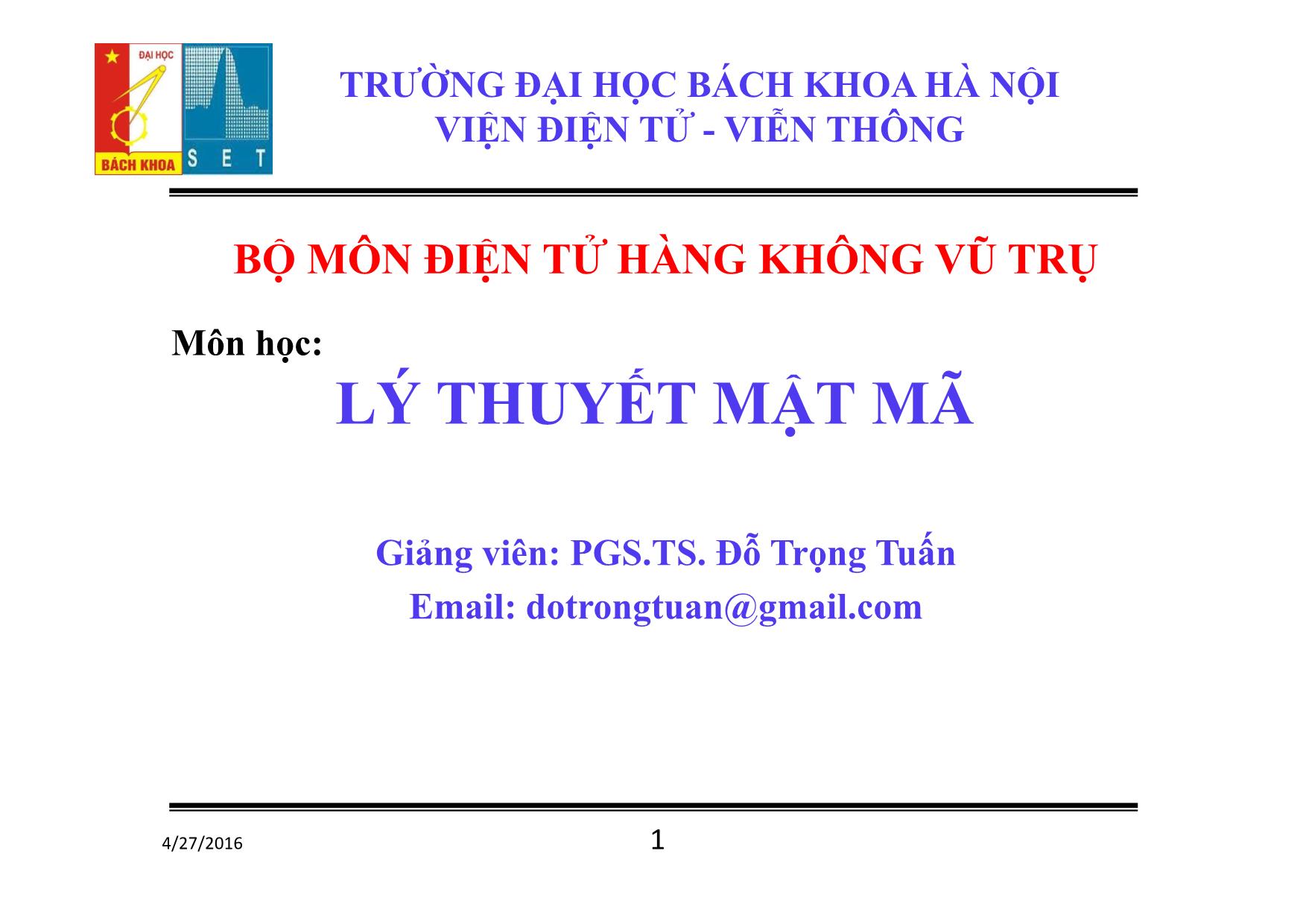
Trang 1
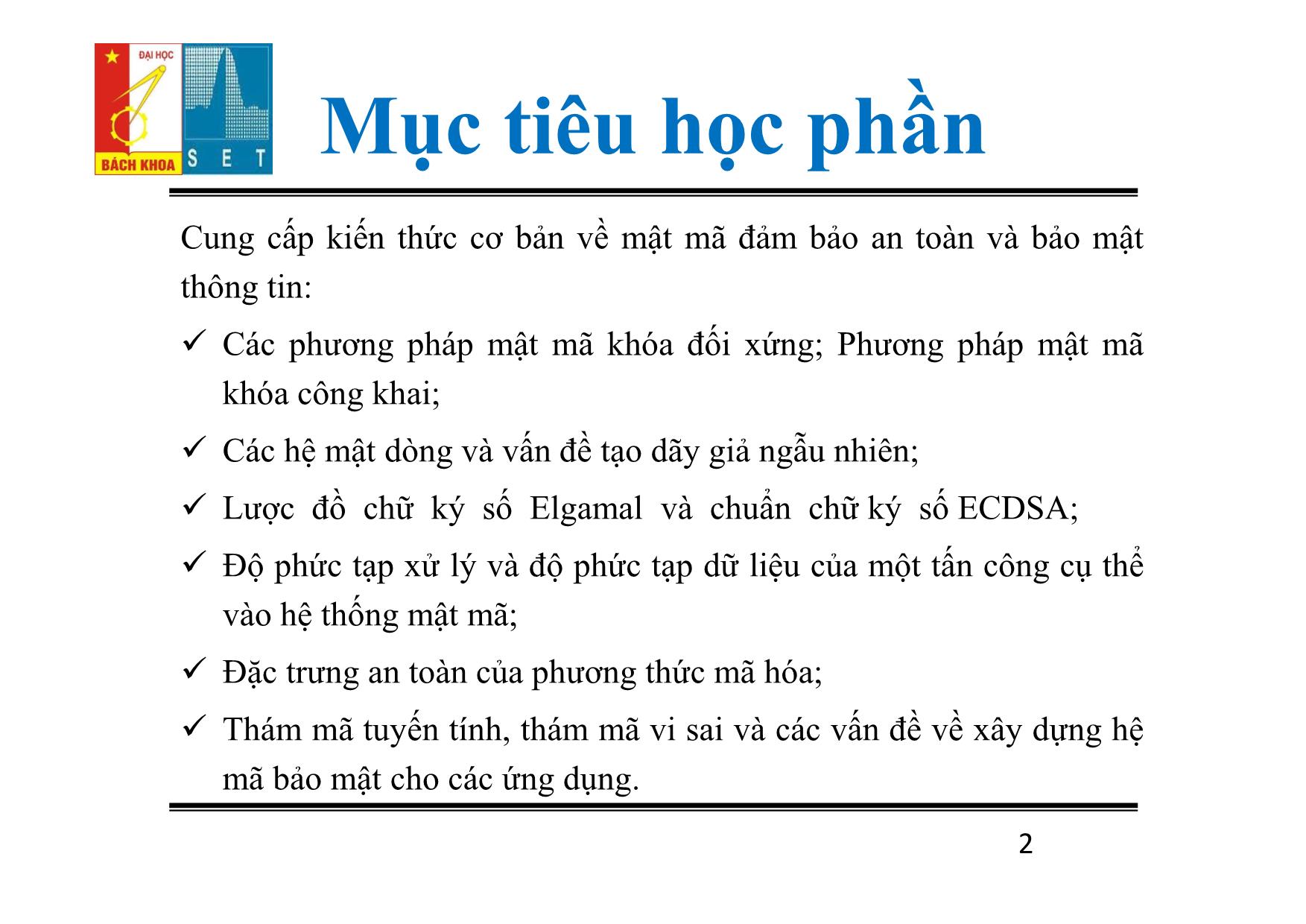
Trang 2
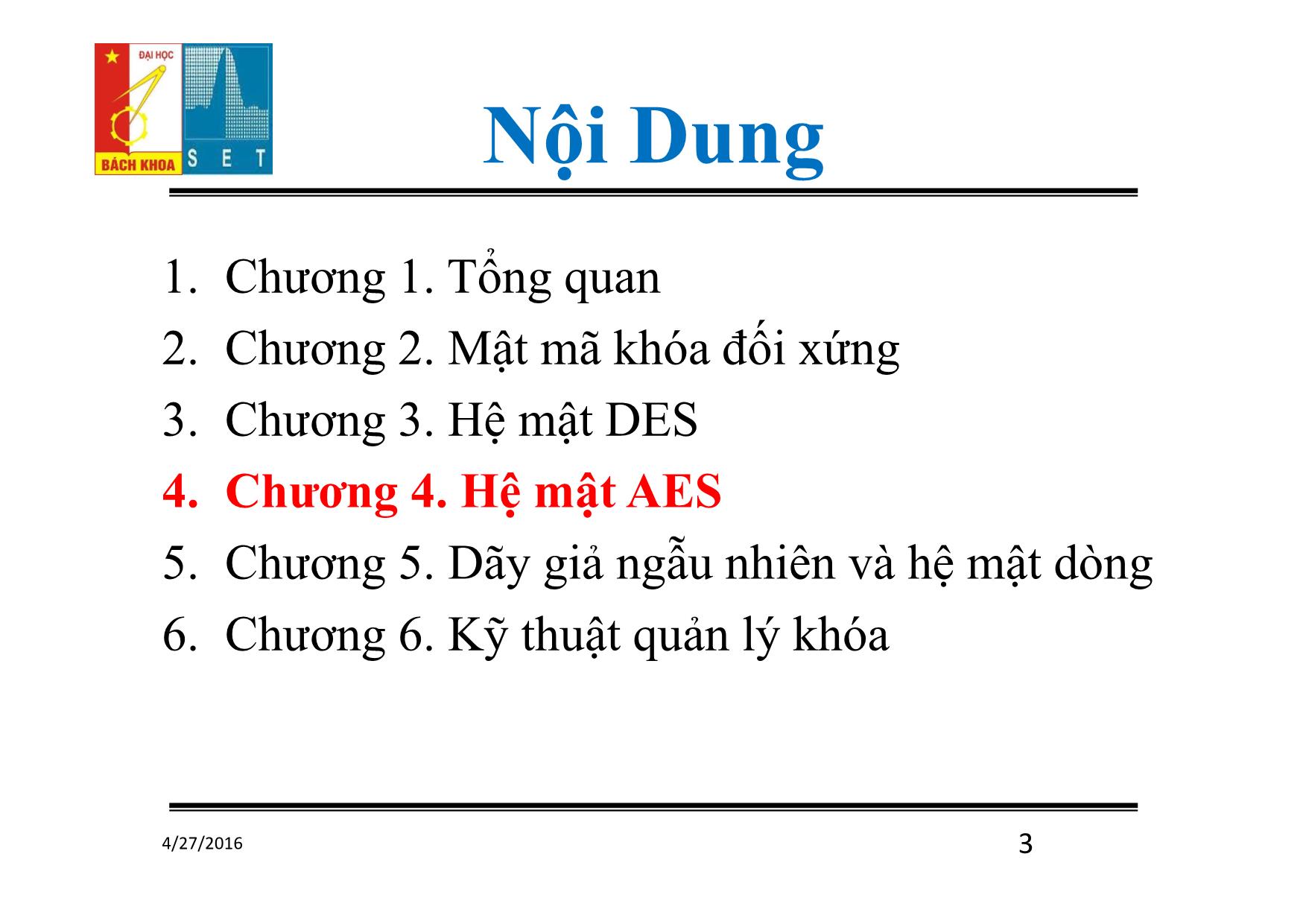
Trang 3
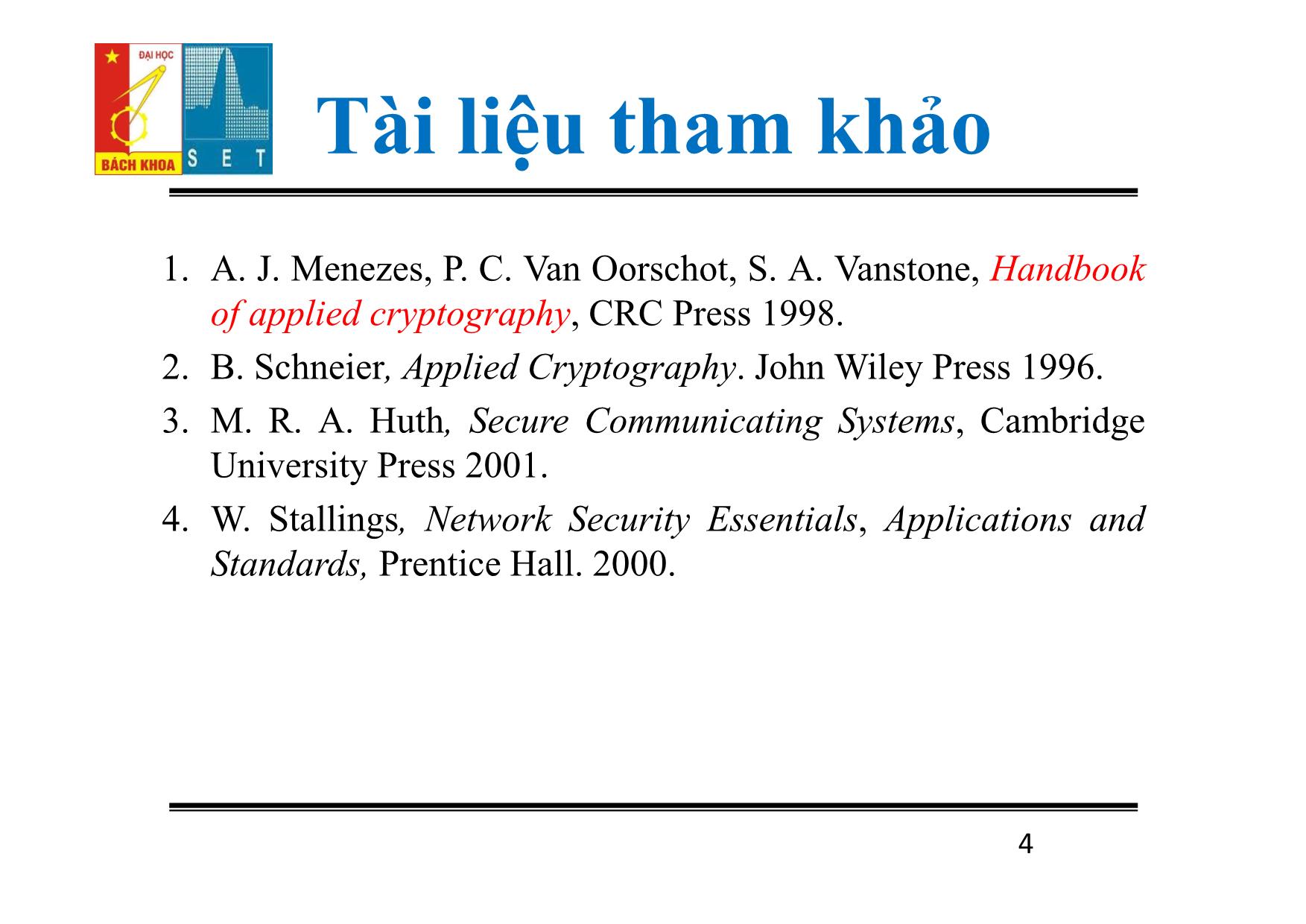
Trang 4
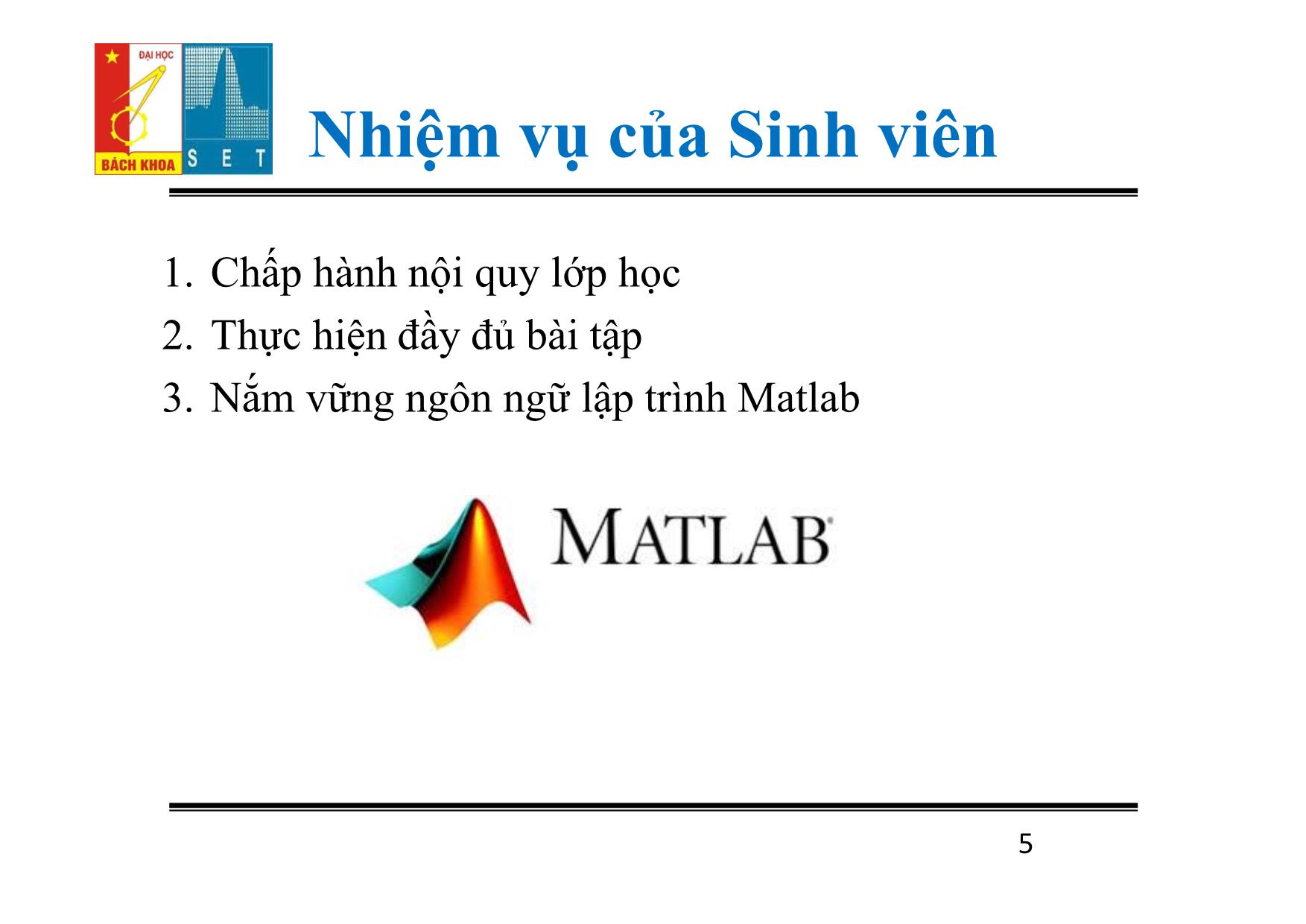
Trang 5
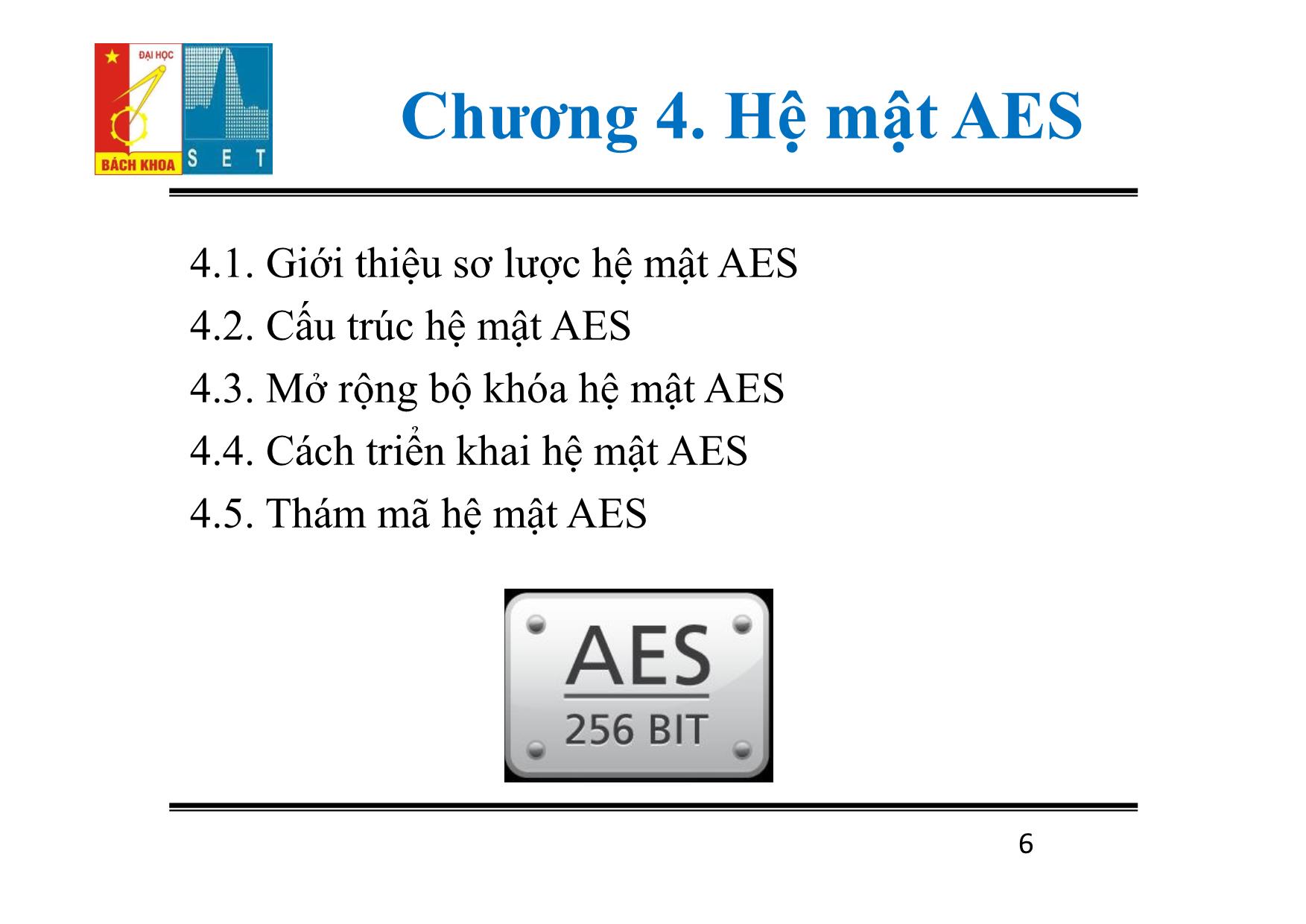
Trang 6
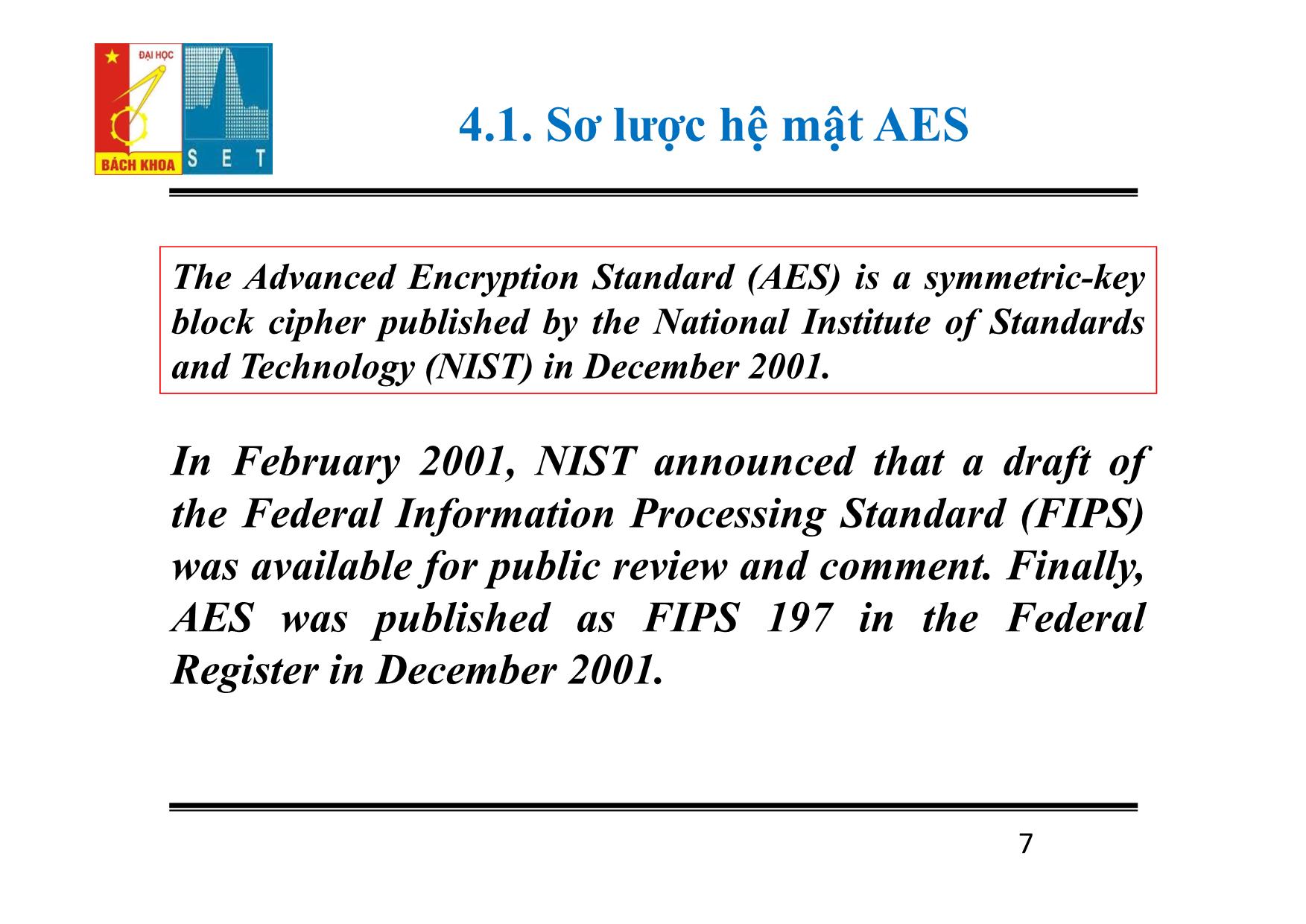
Trang 7
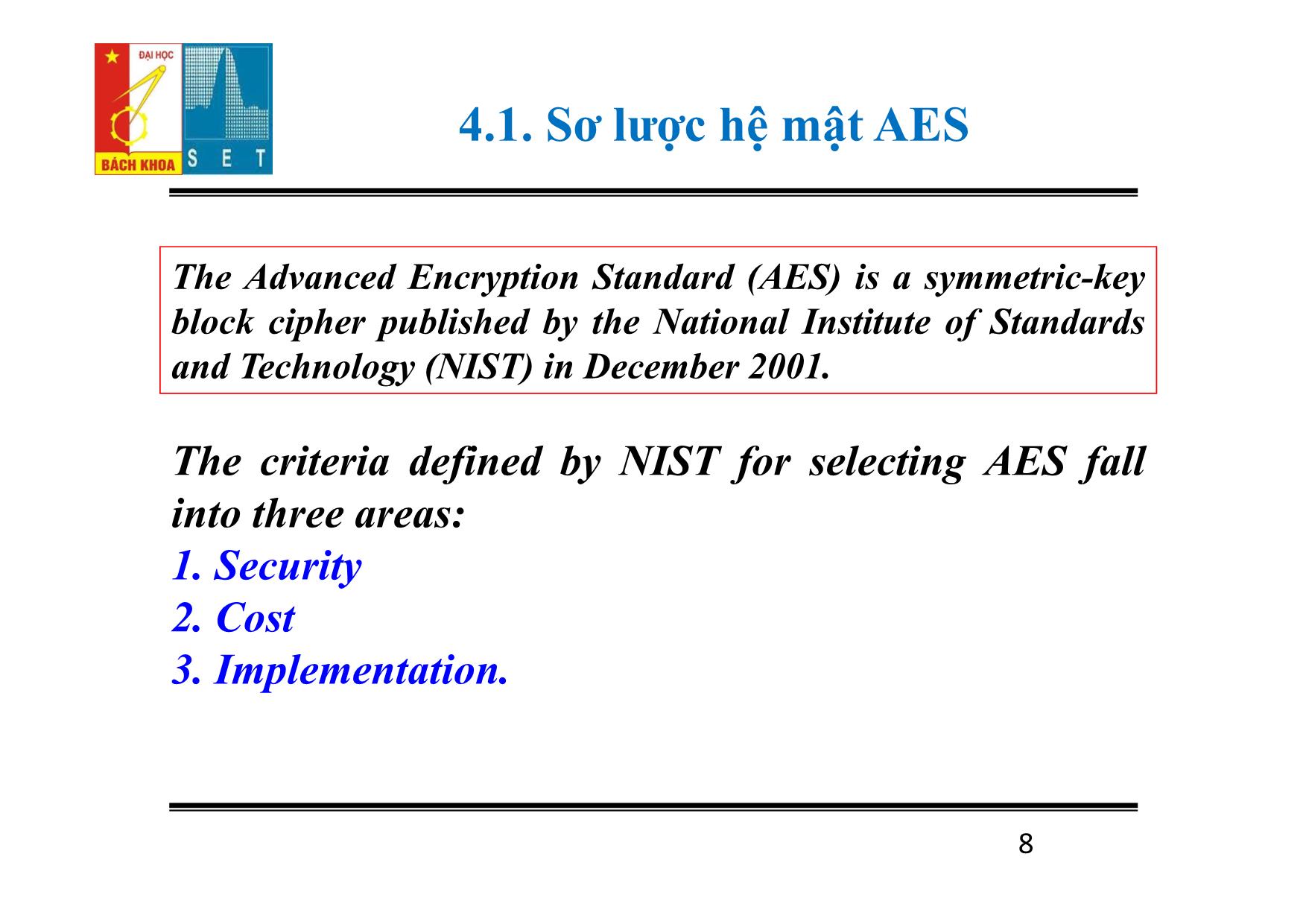
Trang 8
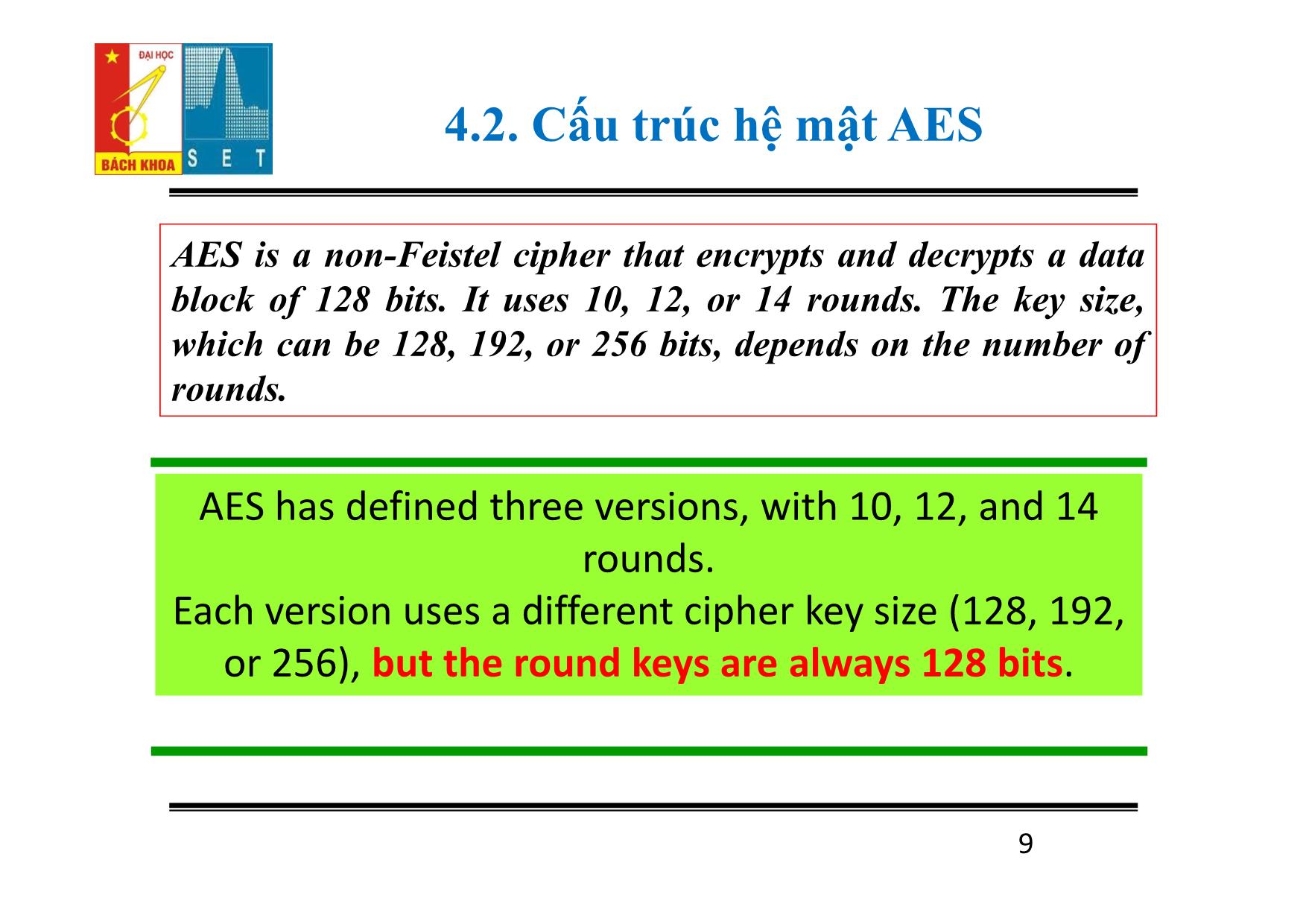
Trang 9
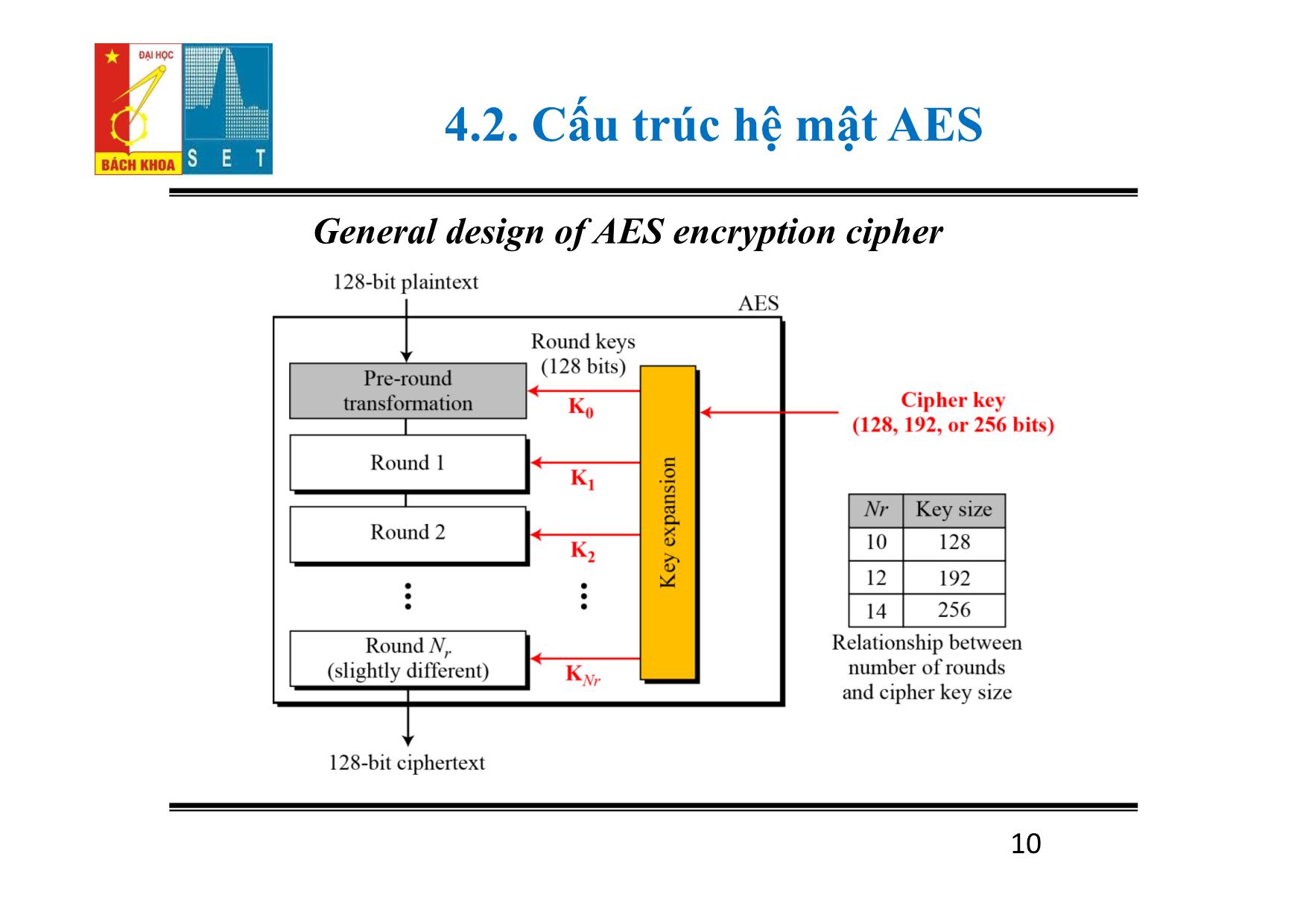
Trang 10
Tải về để xem bản đầy đủ
Tóm tắt nội dung tài liệu: Bài giảng Lý thuyết mật mã - Chương 4: Hệ mật AES - Đỗ Trọng Tuấn

TRƯỜNG ĐẠI HỌC BÁCH KHOA HÀ NỘI VIỆN ĐIỆN TỬ - VIỄN THÔNG BỘ MÔN ĐIỆN TỬ HÀNG KHÔNG VŨ TRỤ Môn học: LÝ THUYẾT MẬT MÃ Giảng viên: PGS.TS. Đỗ Trọng Tuấn Email: dotrongtuan@gmail.com 4/27/2016 1 Mục tiêu học phần Cung cấp kiến thức cơ bản về mật mã đảm bảo an toàn và bảo mật thông tin: Các phương pháp mật mã khóa đối xứng; Phương pháp mật mã khóa công khai; Các hệ mật dòng và vấn đề tạo dãy giả ngẫu nhiên; Lược đồ chữ ký số Elgamal và chuẩn chữ ký số ECDSA; Độ phức tạp xử lý và độ phức tạp dữ liệu của một tấn công cụ thể vào hệ thống mật mã; Đặc trưng an toàn của phương thức mã hóa; Thám mã tuyến tính, thám mã vi sai và các vấn đề về xây dựng hệ mã bảo mật cho các ứng dụng. 2 Nội Dung 1. Chương 1. Tổng quan 2. Chương 2. Mật mã khóa đối xứng 3. Chương 3. Hệ mật DES 4. Chương 4. Hệ mật AES 5. Chương 5. Dãy giả ngẫu nhiên và hệ mật dòng 6. Chương 6. Kỹ thuật quản lý khóa 4/27/2016 3 Tài liệu tham khảo 1. A. J. Menezes, P. C. Van Oorschot, S. A. Vanstone, Handbook of applied cryptography, CRC Press 1998. 2. B. Schneier, Applied Cryptography. John Wiley Press 1996. 3. M. R. A. Huth, Secure Communicating Systems, Cambridge University Press 2001. 4. W. Stallings, Network Security Essentials, Applications and Standards, Prentice Hall. 2000. 4 Nhiệm vụ của Sinh viên 1. Chấp hành nội quy lớp học 2. Thực hiện đầy đủ bài tập 3. Nắm vững ngôn ngữ lập trình Matlab 5 Chương 4. Hệ mật AES 4.1. Giới thiệu sơ lược hệ mật AES 4.2. Cấu trúc hệ mật AES 4.3. Mở rộng bộ khóa hệ mật AES 4.4. Cách triển khai hệ mật AES 4.5. Thám mã hệ mật AES 6 4.1. Sơ lược hệ mật AES The Advanced Encryption Standard (AES) is a symmetric-key block cipher published by the National Institute of Standards and Technology (NIST) in December 2001. In February 2001, NIST announced that a draft of the Federal Information Processing Standard (FIPS) was available for public review and comment. Finally, AES was published as FIPS 197 in the Federal Register in December 2001. 7 4.1. Sơ lược hệ mật AES The Advanced Encryption Standard (AES) is a symmetric-key block cipher published by the National Institute of Standards and Technology (NIST) in December 2001. The criteria defined by NIST for selecting AES fall into three areas: 1. Security 2. Cost 3. Implementation. 8 4.2. Cấu trúc hệ mật AES AES is a non-Feistel cipher that encrypts and decrypts a data block of 128 bits. It uses 10, 12, or 14 rounds. The key size, which can be 128, 192, or 256 bits, depends on the number of rounds. AES has defined three versions, with 10, 12, and 14 rounds. Each version uses a different cipher key size (128, 192, or 256), but the round keys are always 128 bits. 9 4.2. Cấu trúc hệ mật AES General design of AES encryption cipher 10 4.2. Cấu trúc hệ mật AES Data units used in AES 11 4.2. Cấu trúc hệ mật AES Data units used in AES 12 4.2. Cấu trúc hệ mật AES Data units used in AES 13 4.2. Cấu trúc hệ mật AES Block-to-state and state-to-block transformation 14 4.2. Cấu trúc hệ mật AES Structure of each round at the encryption site 15 4.2. Cấu trúc hệ mật AES To provide security, AES uses four types of transformations: substitution, permutation, mixing, and key-adding. 16 4.2. Cấu trúc hệ mật AES AES, like DES, uses substitution. AES uses two invertible transformations. SubBytes The first transformation, SubBytes, is used at the encryption site. To substitute a byte, we interpret the byte as two hexadecimal digits. The SubBytes operation involves 16 independent byte- to-byte transformations. 17 4.2. Cấu trúc hệ mật AES 18 4.2. Cấu trúc hệ mật AES SubBytes table 19 4.2. Cấu trúc hệ mật AES invSubBytes table 20 4.2. Cấu trúc hệ mật AES This figure shows how a state is transformed using the SubBytes transformation. The figure also shows that the InvSubBytes transformation creates the original one. Note that if the two bytes have the same values, their transformation is also the same. 21 4.2. Cấu trúc hệ mật AES Transformation Using the GF(28) Field AES also defines the transformation algebraically using the GF(28) field with the irreducible polynomials (x8 + x4 + x3+ x + 1). The SubBytes and InvSubBytes transformations are inverses of each other. 22 4.2. Cấu trúc hệ mật AES SubBytes and InvSubBytes processes Constant matrix X 23 4.2. Cấu trúc hệ mật AES 24 4.2. Cấu trúc hệ mật AES Another transformation found in a round is shifting, which permutes the bytes. ShiftRows In the encryption, the transformation is called ShiftRows. ShiftRows transformation = Permutation 25 4.2. Cấu trúc hệ mật AES InvShiftRows In the decryption, the transformation is called InvShiftRows and the shifting is to the right. 26 4.2. Cấu trúc hệ mật AES This figure shows how a state is transformed using ShiftRows transformation. The figure also shows that InvShiftRows transformation creates the original state. ShiftRows transformation example 27 4.2. Cấu trúc hệ mật AES Mixing We need an interbyte transformation that changes the bits inside a byte, based on the bits inside the neighboring bytes. We need to mix bytes to provide diffusion at the bit level. Mixing bytes using matrix multiplication 28 4.2. Cấu trúc hệ mật AES Mixing Constant matrices used by MixColumns and InvMixColumns 29 4.2. Cấu trúc hệ mật AES MixColumns The MixColumns transformation operates at the column level; it transforms each column of the state to a new column. MixColumns transformation 30 4.2. Cấu trúc hệ mật AES InvMixColumns The InvMixColumns transformation is basically the same as the MixColumns transformation. The MixColumns and InvMixColumns transformations are inverses of each other. 31 4.2. Cấu trúc hệ mật AES 32 4.2. Cấu trúc hệ mật AES Figure below shows how a state is transformed using the MixColumns transformation. The figure also shows that the InvMixColumns transformation creates the original one. The MixColumns transformation example 33 4.2. Cấu trúc hệ mật AES Key Adding AddRoundKey • AddRoundKey proceeds one column at a time. • AddRoundKey adds a round key word with each state column matrix • The operation in AddRoundKey is matrix addition. The AddRoundKey transformation is the inverse of itself. 34 4.2. Cấu trúc hệ mật AES AddRoundKey transformation 35 4.3. Mở rộng bộ khóa hệ mật AES KEY EXPANSION To create round keys for each round, AES uses a key- expansion process. If the number of rounds is Nr , the key-expansion routine creates Nr + 1 128-bit round keys from one single 128-bit cipher key. • Key Expansion in AES-128 • Key Expansion in AES-192 and AES-256 • Key-Expansion Analysis The key-expansion mechanism in AES has been designed to provide several features that thwart the cryptanalyst. 36 4.3. Mở rộng bộ khóa hệ mật AES To create round keys for each round, AES uses a key-expansion process. If the number of rounds is Nr , the key-expansion routine creates Nr + 1 128-bit round keys from one single 128- bit cipher key. 37 4.3. Mở rộng bộ khóa hệ mật AES Key Expansion in AES-128 38 4.3. Mở rộng bộ khóa hệ mật AES Key Expansion in AES-128 39 4.3. Mở rộng bộ khóa hệ mật AES Key Expansion in AES-128 40 4.3. Mở rộng bộ khóa hệ mật AES Key Expansion in AES-128 41 4.3. Mở rộng bộ khóa hệ mật AES Key Expansion in AES-128 The key-expansion routine can either use the above table when calculating the words or use the GF(28) field to calculate the leftmost byte dynamically, as shown below (prime is the irreducible polynomial): 42 4.3. Mở rộng bộ khóa hệ mật AES Key Expansion in AES-128 43 4.3. Mở rộng bộ khóa hệ mật AES Key Expansion in AES-128 Each round key in AES depends on the previous round key. The dependency, however, is nonlinear because of SubWord transformation. The addition of the round constants also guarantees that each round key will be different from the previous one. 44 4.3. Mở rộng bộ khóa hệ mật AES Ví dụ This table shows how the keys for each round are calculated assuming that the 128-bit cipher key agreed upon by Alice and Bob is (24 75 A2 B3 34 75 56 88 31 E2 12 00 13 AA 54 87)16. 45 4.3. Mở rộng bộ khóa hệ mật AES Ví dụ The concept of weak keys, as we discussed for DES in Chapter 3, does not apply to AES. Assume that all bits in the cipher key are 0s. The following shows the words for some rounds: The words in the pre-round and the first round are all the same. In the second round, the first word matches with the third; the second word matches with the fourth. However, after the second round the pattern disappears; every word is different. 46 4.3. Mở rộng bộ khóa hệ mật AES Key-expansion algorithms in the AES-192 and AES-256 versions are very similar to the key expansion algorithm in AES-128, with the following differences: 47 4.4. Cách triển khai hệ mật AES • AES uses four types of transformations for encryption and decryption. • In the standard, the encryption algorithm is referred to as the cipher and the decryption algorithm as the inverse cipher. - Original Design - Alternative Design 48 4.4. Cách triển khai hệ mật AES Original Design Ciphers and inverse ciphers of the original design 49 4.4. Cách triển khai hệ mật AES 50 4.4. Cách triển khai hệ mật AES Alternative Design • In this version, the transformation in the reverse cipher are rearranged to make the order of transformations the same in the cipher and reverse cipher. • In this design, invertibility is provided for a pair of transformations, not for each single transformation 51 4.4. Cách triển khai hệ mật AES Alternative Design Cipher and reverse cipher in alternate design 52 4.4. Cách triển khai hệ mật AES Alternative Design Changing Key-Expansion Algorithm Instead of using InvRoundKey transformation in the reverse cipher, the key-expansion algorithm can be changed to create a different set of round keys for the inverse cipher. Note that: - The round key for the pre-round operation and the last round should not be changed. - The round keys for round 1 to 9 need to be multiplied by the constant matrix 53 4.4. Cách triển khai hệ mật AES Alternative Design Ví dụ The following shows the ciphertext block created from a plaintext block using a randomly selected cipher key. 54 4.4. Cách triển khai hệ mật AES 55 4.4. Cách triển khai hệ mật AES 56 4.4. Cách triển khai hệ mật AES 57 4.4. Cách triển khai hệ mật AES This figure shows the state entries in one round, round 7. States in a single round One may be curious to see the result of encryption when the plaintext is made of all 0s. 58 4.4. Cách triển khai hệ mật AES The avalanche effect 59 4.4. Cách triển khai hệ mật AES The following shows the effect of using a cipher key in which all bits are 0s. 60 4.5. Thám mã hệ mật AES AES was designed after DES. Most of the known attacks on DES were already tested on AES. Brute-Force Attack AES is definitely more secure than DES due to the larger-size key. Statistical Attacks Numerous tests have failed to do statistical analysis of the ciphertext. Differential and Linear Attacks There are no differential and linear attacks on AES as yet. 61 4.5. Thám mã hệ mật AES Statistical Attacks Numerous tests have failed to do statistical analysis of the ciphertext. Differential and Linear Attacks There are no differential and linear attacks on AES as yet. 62
File đính kèm:
 bai_giang_ly_thuyet_mat_ma_chuong_4_he_mat_aes_do_trong_tuan.pdf
bai_giang_ly_thuyet_mat_ma_chuong_4_he_mat_aes_do_trong_tuan.pdf

